Matang Wildlife Centre
If you’re looking for a feel‑good, nature‑rich day out near Kuching, set your sights on Matang Wildlife Centre. Tucked against the lush foothills of Kubah National Park, this recommended attraction brings you face to face with Borneo’s charismatic creatures while shining a light on their stories of rescue, rehabilitation, and release.
It’s part sanctuary, part learning hub, and entirely inspiring for visitors of all ages. Visiting both this centre and Kubah National Park are recommended as they are located nearby.
 Matang Wildlife Centre Entrance
Matang Wildlife Centre EntranceMatang Wildlife Centre Purpose
What makes Matang Wildlife Centre special is its mission. Many residents were confiscated from the illegal pet trade or brought in after habitat loss. The centre’s priority is rehabilitation—some animals are candidates for eventual release, while others are given lifelong care.
Think of it less as a traditional zoo and more as a window into the real work of Conservation of animals in Sarawak.
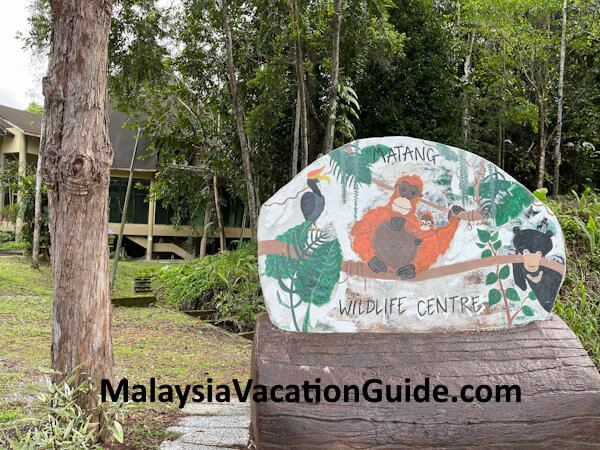 Compound of the wildlife centre
Compound of the wildlife centre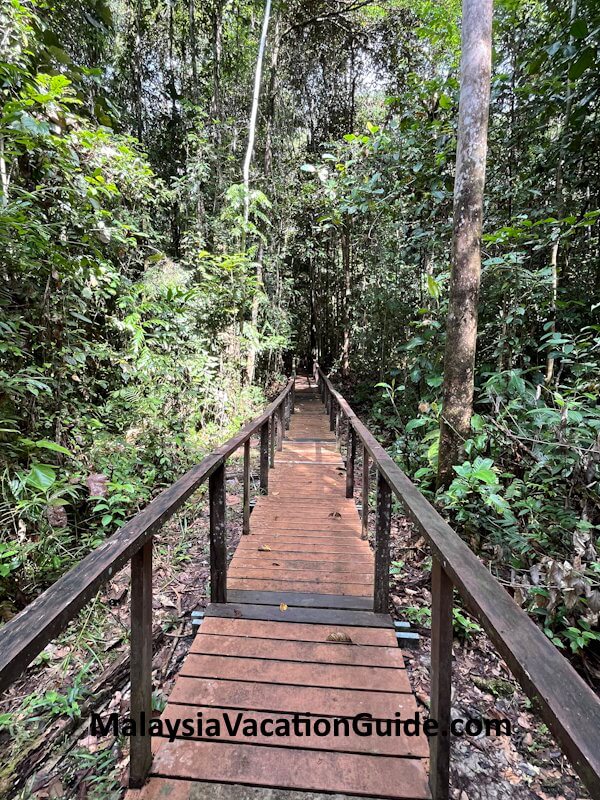 Well constructed boardwalk towards the enclosures of the animals
Well constructed boardwalk towards the enclosures of the animals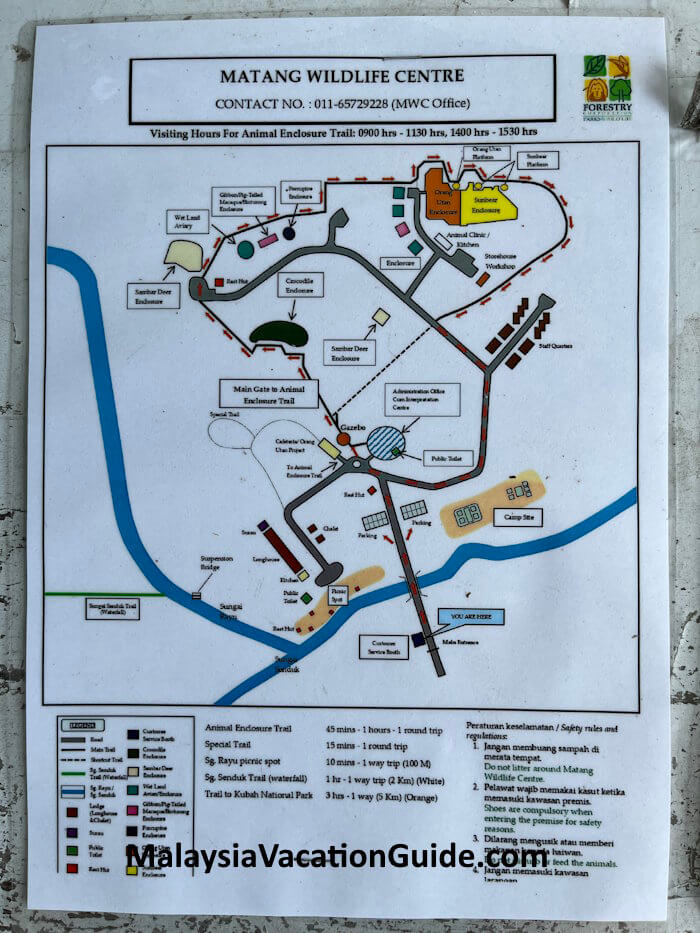 Matang Wildlife Centre Map
Matang Wildlife Centre MapEndangered Animals
On arrival, check the map and follow the forested loop paths that link the enclosures and aviaries. A relaxed circuit with photo stops typically takes a couple of hours. Facilities are basic but convenient, and rangers or guides can help with current viewing tips.
Here are some of the animals that you may see at the centre.
Orang Utans
The undisputed icons of Borneo, these great apes are all gentle power and quiet intelligence. Look for their long arms (spanning well over their height), shaggy rust‑orange hair, and soulful eyes that mirror a complex inner life. Adult males may sport cheek pads and a prominent throat pouch, while females are more lightly built and often seen moving deliberately, hand over hand.
At the centre, you might catch them fashioning leafy nests, testing puzzle‑feeders, or foraging with astonishing dexterity. Their diet is mainly fruit, leaves, and bark, with the occasional insect snack—watch how they inspect food with almost human‑like care. Seeing them here underscores why protection of forest corridors is essential for these deeply arboreal apes.
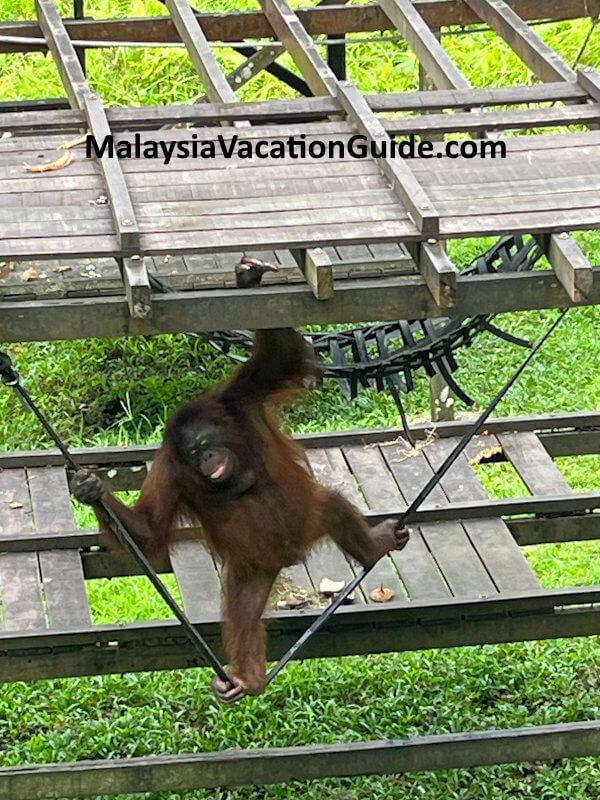 Orang Utan having a fun time
Orang Utan having a fun time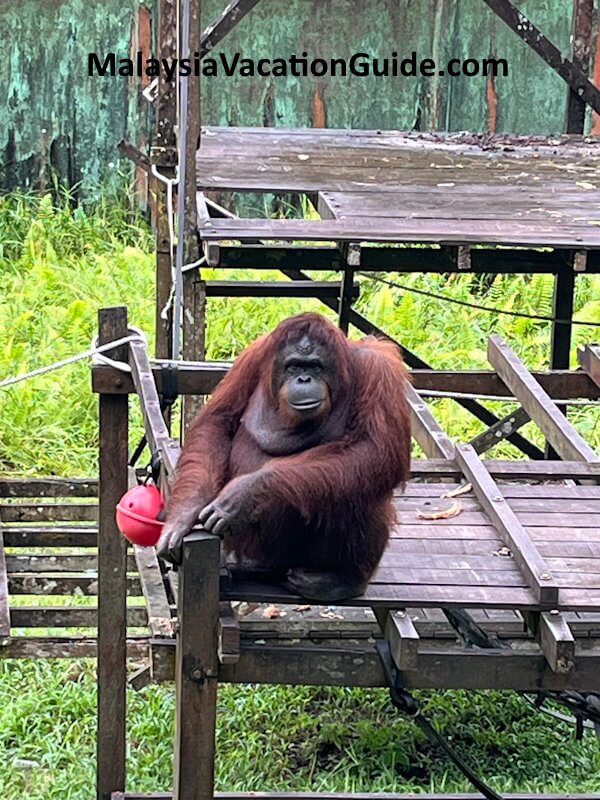 Orang Utan taking a rest
Orang Utan taking a restBinturong
With a shaggy black coat, prehensile tail, and whiskered face, the binturong looks like a mash‑up of cat, bear, and civet—hence the nickname. They move slowly and deliberately, using that muscular tail as a fifth limb when climbing.
If the air smells faintly of buttered popcorn, you’re onto them: the scent of their musk glands is unmistakable. As fruit‑loving omnivores, binturongs are invaluable seed dispersers, helping regenerate forest patches that other wildlife later relies on.
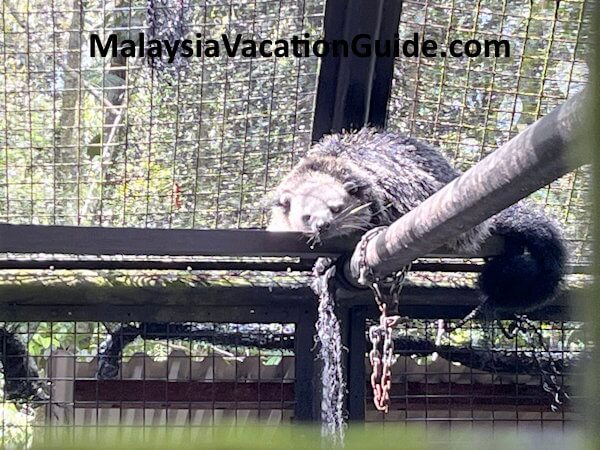 Binturong resting
Binturong restingSun bear
The smallest of the world’s bears carries a big personality. Compact and muscular with a glossy black coat and a cream “sun” crescent on the chest, sun bears are master climbers. Their extra‑long tongue is perfect for raiding honey and termites, and those impressive, curved claws can open logs as if they were cardboard.
If you spot one up a structure or tree, notice the pigeon‑toed gait and the keen nose at work—sun bears navigate their world through scent as much as sight. They are shy by nature and considered vulnerable, so every rescued individual here is part of a broader story of forest protection and reduced human‑wildlife conflict.
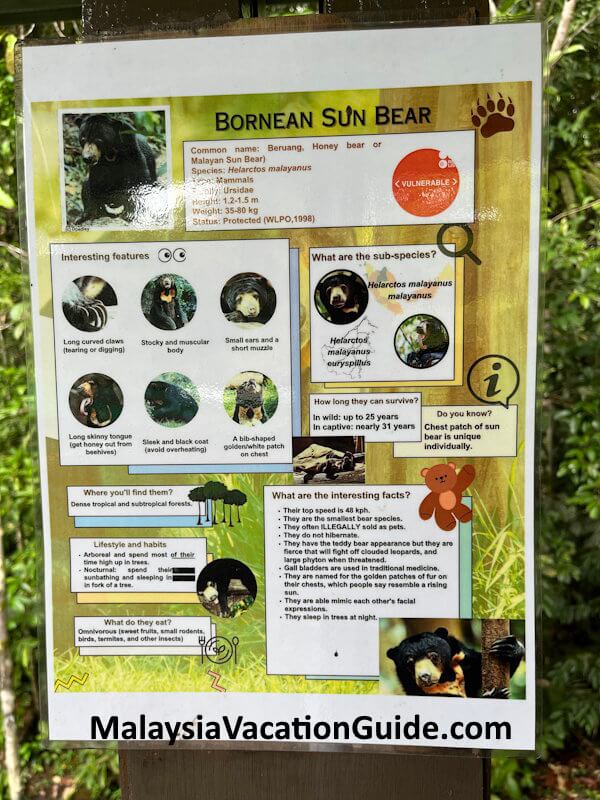 Bornean Sun Bear Info
Bornean Sun Bear Info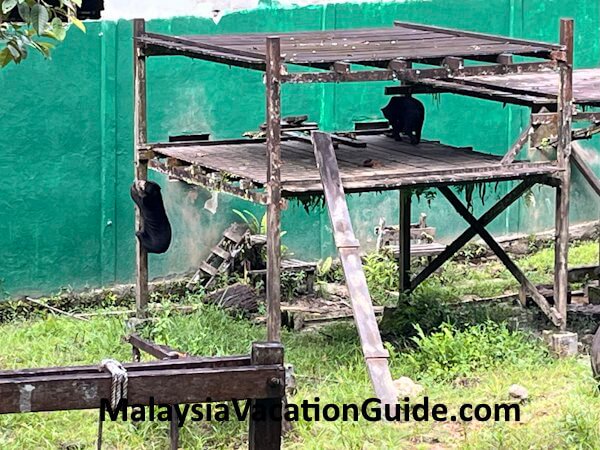 Bornean Sun Bear
Bornean Sun BearHornbills
Nothing says Borneo quite like a hornbill slicing over the canopy. Look for imposing bills capped with a casque, bright facial skin, and powerful wingbeats that whoosh audibly as they fly. In aviaries, study their courtly behavior: male hornbills often present food to mates, an echo of the wild nesting ritual where females are sealed into tree cavities while the male provisions through a narrow slit.
Fruit is their staple, but many species snap up insects and small animals, playing a key role in seed dispersal.
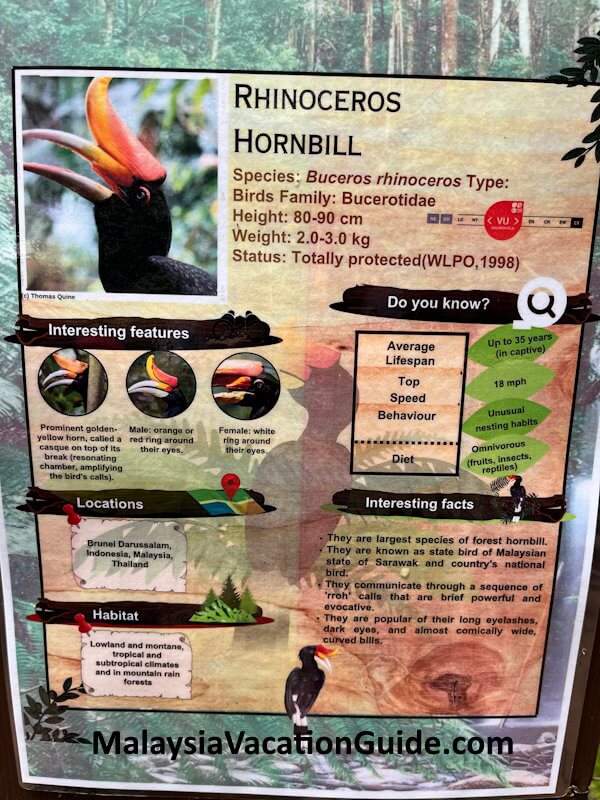 Facts on Rhinoceros Hornbill
Facts on Rhinoceros Hornbill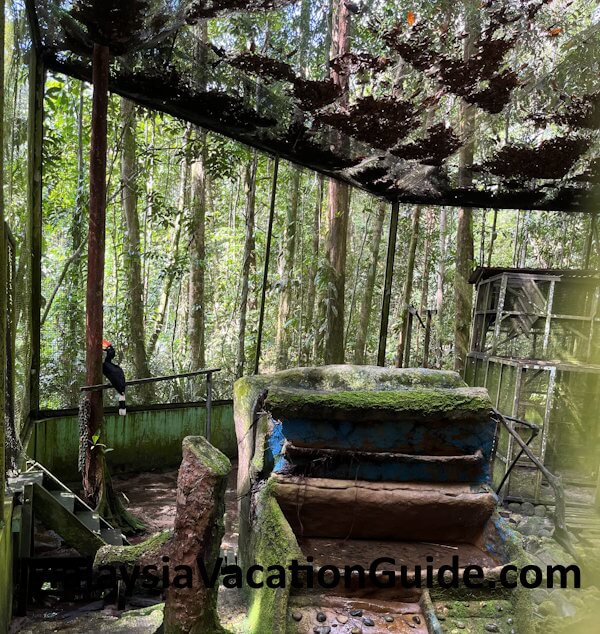 A closer look at the Hornbill is possible at the centre
A closer look at the Hornbill is possible at the centreCrocodiles
The estuarine (saltwater) crocodile is Southeast Asia’s heavyweight reptile, perfectly engineered for ambush. Note the armored scales, ridged tail, and eyes and nostrils set high for low‑profile stalking. Even in calm repose, a croc radiates prehistoric power.
They are apex predators and a reminder to respect Sarawak’s tidal rivers and mangroves; here you can safely appreciate their adaptations—valved ears, a palatal flap, and jaw muscles built more for crushing grip than for opening.
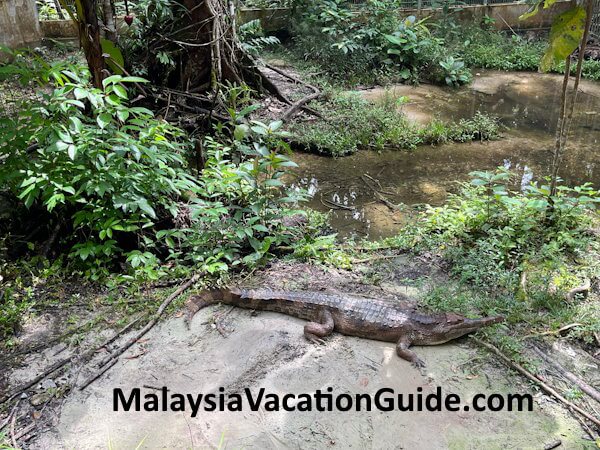 Crocodile
CrocodilePorcupines
Bristling with quills and surprisingly nimble, porcupines are gentle foragers that would rather shuffle away than spar. Their quills, banded and hollow in places, can rattle when shaken as a warning.
Look for powerful front teeth working through roots and tubers and a preference for dusk activity. While not aggressive, they are well defended—predators learn quickly to think twice.
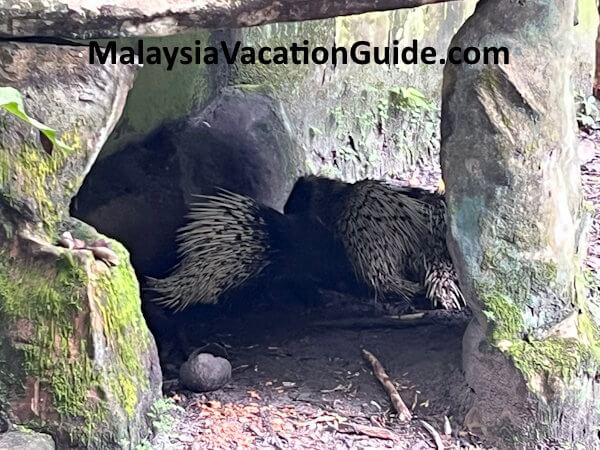 Porcupines
PorcupinesGibbons: These are the forest’s aerial acrobats. Slim and long‑limbed with no tail, gibbons move by brachiation—swinging hand‑over‑hand with astonishing speed and grace.
Their haunting morning songs ripple through the trees, a duet that strengthens pair bonds and stakes out territory. Look for thick, silky fur and a curious, alert gaze; you might catch a gibbon rocketing across a rope with effortless rhythm, then settling into a thoughtful, upright sit to groom. Fruit and young leaves top the menu, and their presence signals healthy, continuous canopy.
Macaques: Social, adaptable, and very smart, macaques are the consummate survivors of Southeast Asian forests. You may see long‑tailed macaques with their expressive brows and lanky tails, or more robust, shorter‑tailed relatives.
Watch for grooming circles where trust is strengthened hair by hair, and for deft fingers prying seeds from pods. Their omnivorous diet and quick learning make them fascinating—but also easily habituated—so keep food sealed and interactions respectful.
Sambar deer: These sturdy forest deer wear a coarse, chocolate‑brown coat and carry robust, three‑tined antlers in adult males. Sambar are crepuscular browsers, favoring leaves, shoots, and fallen fruit.
Despite their size, they can melt into cover with a few silent steps, aided by large ears that swivel like satellite dishes. Look for them ruminating in the shade or nibbling browse, eyes soft but alert.
Leopard cat: Petite and beautifully patterned, leopard cats resemble a wild echo of domestic tabbies—with bigger eyes, longer legs, and a tail tipped in black. Nocturnal and shy, they hunt rodents, birds, and insects with catlike patience and lightning pounces. In daylight, you might see one resting in a quiet nook, its coat a tapestry of rosettes and spots evolved for dappled forest light.
Civets: Sleek, nocturnal, and wonderfully aromatic (to other civets at least), these small carnivores are the forest’s quiet gardeners. Feeding on fruit, insects, and small vertebrates, they disperse seeds far and wide.
You may notice elongated bodies, pointed muzzles, and banded tails; their masked faces lend them a mischievous look. In a rehabilitation setting, civets remind us that even lesser‑known species are vital threads in Borneo’s ecological fabric and, in many cases, count among the region’s endangered animals.
Best Time To Visit
Plan your visit for the cooler early hours when wildlife is typically most active and the forest chorus is in full swing. Move slowly, keep voices low, and linger—patience often rewards you with natural behaviors like foraging, grooming, or birds preening. Do respect signs and barriers: no feeding, no tapping on enclosures, and no flash photography.
Dress light but modest, wear comfortable walking shoes, and bring rain protection—showers are part of the rainforest charm. Insect repellent, a reusable water bottle, and a pair of binoculars go a long way.
Photograph thoughtfully: natural behavior beats forced reactions every time. Most of all, remember your visit helps support care, habitat protection, and public education for the animals you’ve just met.
If you have extra time, pair your visit with nearby forest walks in Kubah National Park for frogs, ferns, and sweeping views, or explore Kuching’s riverfront for culture and cuisine.
Whether you come for close‑up encounters with orang utans, the deep‑forest chorus of gibbons, or the majesty of hornbills, Matang Wildlife Centre offers a humane, educational window into Borneo’s wild heart—and an easy way for travelers to be part of something bigger.
Getting Here & Contacts
Getting here is straightforward: Matang Wildlife Centre is about 40 minutes drive from Kuching, and taxis, e‑hailing rides, and organized day tours are readily available.
If you are not driving, tt's better to ensure you book a transport back to your hotel as it's difficult to get e-hailing rides or taxi from here.
Roads are sealed and the final approach winds through verdant villages and rainforest, setting the mood long before you arrive.
Entrance Fees:
RM10/adult and RM3/child for Malaysian.
RM20/adult and RM7/child for Foreigners.
You can use the same ticket to enter if you visited Kubah National Park on the same day. Call the centre before coming here to ensure that it's open on your day of visiting.
Operation Hours: 9am-11:30am, 2pm-3:30pm (Mon-Sun)
Matang Wildlife Centre
Tel: +6011-6572 9228 / +6011-6572 9293
Terengganu | Perak | Malaysia Hotels | Airlines | Shopping
Pulau Perhentian | Beaches & Islands | Highlands | Theme Parks
Museums & History | Landmarks | Public Transports | Videos
Souvenir | Calendar 2025 | Tourism Centre | Cyberjaya | Golfing
Penang Food | KTM | Beruas Museum | Selangor | Templer's Park
Pulau Ketam | KLIA2 | Pulau Sibu | Advertise With Us







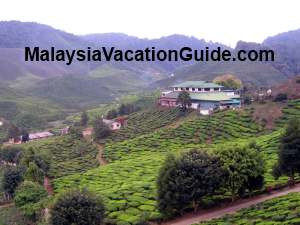



New! Comments
Have your say about what you just read! Leave us a comment in the box below.